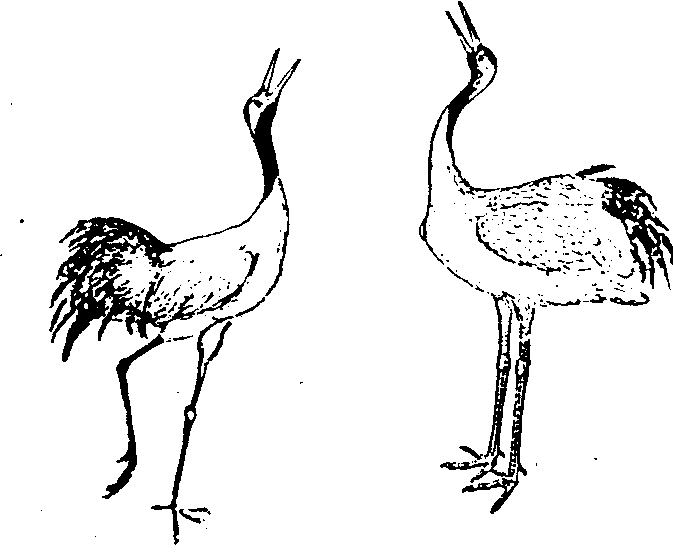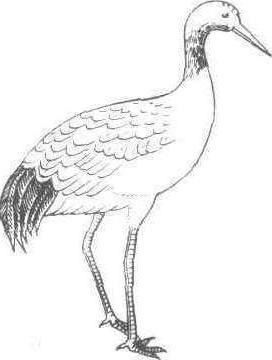042 丹顶鹤
又名“仙鹤”,古人认为它是神仙坐骑。鹤形目,鹤科。体长1.2米余。体羽主要为白色。喉、颊和颈部暗褐色。尾短,喙、颈和腿均长,素谓“三长”。头顶皮肤裸露,呈朱红色。飞羽黑色,两翼折迭,覆于整个白色短尾上,每被人误为尾羽亦黑。鸣管长,鸣声高亢响亮。飞翔力强。栖息于沼泽地带,取食鱼、昆虫、甲壳类、蛙类等,兼食水草和谷类。迁徙性,每年3月由南方迁至北方繁殖地。4月以鸣叫、舞蹈行为求偶。由雄鹤跳跃或飞起落在雌鹤背上进行交配。每年产卵1窝,每窝有卵2枚,偶有3枚。由雄、雌鹤轮流孵卵,孵化期31—33天,5月开始出雏,出壳后即能蹒跚而行,为早成鸟。幼鹤4个月后便可随亲鹤飞翔,并迁飞至南方越冬。寿命50—60年。现我国黑龙江齐齐哈尔的扎龙(国家鹤类保护区)、三江平原和吉林向海、辽宁盘锦等地为其繁殖地;江苏盐城、灌云等沿海滩涂和安徽内陆湖河一带为越冬地。我国养鹤历史悠久,《东周列国志》有“卫懿公好鹤亡国”的记载。历来以鹤与松为长寿之象征,亦作画在一起,曰:“松鹤延年”。实则鹤为栖于沼泽地的涉禽,与松并无生态间的关系。在日本北海道,由于人工投食,已丧失迁徙习性; 在台湾为罕见冬候鸟。列国家一级保护动物。
丹顶鹤dandingheGrus japo-nensis
脊椎动物,鸟纲,鹤科。为世界著名的珍贵鸟类,体长在1.2米以上。体羽大部分为白色。喉、颊和颈部暗褐色。嘴、颈和跗跖都较长。头顶皮肤裸露,呈朱红色,俗称“丹顶”,但幼时头顶不红。走动和休息时,长而下垂的黑色次级和三级飞羽覆于白色短尾羽上,易误认为是黑色尾羽。起飞时,颈脚直伸,飞翔力强。雌雄的外形不易区别,雄鸟鸣声宏亮,鸣叫时嘴直向天空,并高举翅膀。常涉于近水浅滩,喜捕食小鱼、蝌蚪、昆虫等动物,也吃植物的嫩芽,在我国黑龙江省嫩江中、下游的沼泽地区营巢产卵。其巢简陋,呈盘状。每窝产2个卵,经31天左右孵化。幼鸟出壳后2天便跟随亲鸟漫浮觅食。一般“一夫一妻”制,共同孵卵育雏,幼雏半年后即可随亲鸟南飞越冬。苏联西伯利亚东部、日本和朝鲜也有少量分布。冬季迁长江下游一带越冬,台湾省为罕见冬候鸟。寿命可长达五六十年,又称“仙鹤”。因极为珍稀而被列为国家一级保护动物。可供观赏。

图347 丹顶鹤
丹顶鹤Grus japonensis
鹤科。为世界著名的珍贵涉禽。体长在1.2米以上。体羽主要为白色,喉、颊和颈部暗褐色。尾羽极短,但嘴、颈和腿都很长。头顶皮肤裸露,呈朱红色,因而得名。但幼时头顶不红。三级飞羽黑色长而下垂,走动和休息时,覆于短尾羽上面,常被误认是黑色尾羽。飞翔力强。雌雄的外形不易区别,雄鸟鸣声洪亮,用淡灰绿色的长嘴直伸天空,并高举翅膀跳跃。丹顶鹤寿命可长达五六十年,民间曾长期误传为“仙人”的坐骑,故俗称“仙鹤”。因极为珍稀而被列为国家一级保护动物,可供观赏。鹤为世界著名文化鸟类,深受世界各国人民的喜爱。我国自古即将鹤视为吉祥、长寿的象征,不仅宫廷苑囿和士大夫的庭院中常有驯鹤、养鹤的记载。甚至清代一品文官的补服上,也以仙鹤作为最高品级图案来显示高雅华贵。我国古今的诗歌词曲、绘画刺绣、文艺雕塑和音乐舞蹈等,也多以鹤类为题材,足见爱鹤之深。宋诗人林逋(967~1028)无妻无子,隐居在西湖孤山,靠养鹤种梅以自娱。当林逋外出游西湖时,每有客人来访,家僮即开笼放鹤,主人远望饲鹤飞上天空,即知有客,遂棹舟返家。在与客人酌酒吟诗时,鹤也飞鸣起舞,为主客助兴。宋代文人张天骥,养鹤两只,并在今江苏徐州云龙山顶建盖一座“放鹤亭”。每日清晨登亭放鹤,傍晚在亭招鹤,曾作《招鹤歌》。由此可见,我国人民自古便以爱鹤、护鹤为乐事。现今民间养鹤者虽不多见,但国家笼养鹤数和种类之多,仍居世界首位。尤其是国家对鹤类自然保护区的建立和对鹤类保护措施的制定,近年,鹤类种群数量已有显著增加。

丹顶鹤
丹顶鹤
珍禽。一称“仙鹤”。古称“仙客”、“阳鸟”、“丹哥”、“紫卿”、“蓬莱羽士”等。鸟纲,鹤科。体长在1.2米以上。体羽主要为白色。翅翼、颈部与喉、颊呈黑褐色,头顶呈朱红色。高足、长颈。体态优美,高雅庄重。由于它美丽,又因为它寿长,自古即被人们奉为稀世之珍,作为吉祥和长寿的象征。鸣声响亮,飞翔力强。喜在水塘、芦荡、泽畔生活。以鱼和水中植物为食。是为候鸟,随着季节不同而作定时迁徙。春天,成群结队地由南方飞来,生息繁衍在吉林、黑龙江两省部分地区,入秋后携幼鸟开始南迁长江下游地区。在扎龙保护区,经过多年驯养,有些丹顶鹤已逐渐变成“留鸟”。据推算,目前世界上大约有2000只,中国约有1000只。供观赏展览,飞羽和尾羽可制扇。现已被吉林省定为省鸟。
丹顶鹤redcrowned crane
Grus japonensis Muller,又称仙鹤。鸟纲,鹤形目(Gruiformes)、鹤科(Gruidae)。体形大,体长约1.2 m。体羽大部白色。头顶皮肤裸露,呈朱红色。颈和跗蹠均长。飞羽黑色,次级和三级飞羽形长弯曲成弓状,两翼折叠时覆于白色尾羽上,故常被误认为黑色尾羽。鸣声高吭响亮,与特殊发声器有关。飞翔力强。常涉于近水沼泽海滩,主食芦苇、水草以及鱼、虾、蛙等。夏季育雏时也捕食昆虫。在沼泽地区营巢繁殖,每窝产卵两枚,雌雄轮流孵卵,孵卵期31天左右。早成鸟。分布于中国东北、俄罗斯西伯利亚、朝鲜半岛和日本,秋季至江苏沿海及安徽等地越冬。中国一级保护动物。

丹顶鹤
丹顶鹤
属鸟纲鹤科。别名仙鹤,中国国家I级保护动物。在嫩江、松花江和乌苏里江流域繁殖;在长江下游及沿海越冬;在河北、山东为旅鸟,台湾省偶见。大型涉禽,全长140~150cm。颈腿较长。主要栖息于开阔平原上的芦苇沼泽和草甸上。秋冬季常结成数10或上百只集群活动。4月中、下旬开始营巢产卵。巢外径(107~170cm)×(104~130cm),深4~5cm,巢周水深5~25cm,水面上部分巢高11~20cm。巢间距最近为300m。每年繁殖1窝,每窝产2枚卵,偶有1枚或3枚。产卵时间多在4月末~5月中旬,卵椭圆形,大小为(66.1~75mm)×(101~115mm),重215~295g,孵化期32d左右。全世界大约有2000只丹顶鹤,中国约有1000只,主要产地在黑龙江省。
丹顶鹤
每年10—11月迁徙于江苏沿海滩涂和长江中下游的江西鄱阳湖、安徽升金湖等地越冬,次年三月相继飞往我国东北、内蒙、俄罗斯西伯利亚东部以及朝鲜等地。属鸟纲、鹤形目、鹤科动物,因成鸟头顶露呈朱红色,故名。又名仙鹤。体长1.2米以上,羽毛多为白色。喉、颊和颈部为暗褐色。翅膀飞羽黑色,属于涉禽类,腿、颈均长,常涉于浅水近滩,捕食鱼、虫、蚌、螺、甲壳类、蛙等及水草。色彩瑰丽,体姿优美,有“禽中美人”之称,是吉祥长寿象征。飞羽、尾羽可作羽制品。属国家一级保护动物,1979年在黑龙江建立扎龙自然保护区,1984年在江苏建立盐城珍禽自然保护区,保证其繁衍生息。